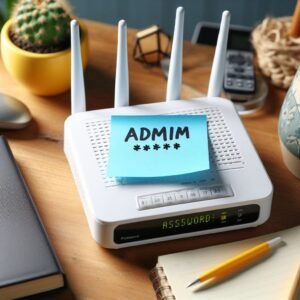Router Default Passwords
The Number One Security Mistake Everyone Makes

Here is the problem in one line. If your router still uses the default username and password, your entire home network sits unlocked behind a thin curtain. Not a steel door. A curtain. Attackers know the factory defaults for common routers. They scan the internet, find reachable devices, try the well known credentials, and walk right in. When they do, they can see your traffic, hijack your DNS, plant malware, and pivot to every phone and laptop at home.
Let me explain what matters, how attacks actually work, and the exact steps to fix it right now. I will also show you where to add images so your readers stay engaged and actually act.
What a Router Default Password Really Is
Every router leaves the factory with a starter login. Think admin with a simple password, sometimes even blank. Vendors expect you to change it during setup. Many people never do. Others assume their Wi Fi password is the same thing as the router login. It is not. Your Wi Fi passphrase protects the wireless network. The router login protects the device that runs your network. If the second one is weak or unchanged, everything else is at risk.
Why Default Credentials Are So Dangerous
Here is what an attacker can do after logging in with your default password.
-
Change your DNS settings to send you to fake banking pages or malware sites.
-
Open remote access so they can get back in later without scanning.
-
Turn your router into a node in a botnet used for fraud, phishing, or denial of service attacks.
-
Watch or redirect traffic from devices on your network. That includes work laptops, smart cameras, and your child’s tablet.
-
Break your connection or throttle you until you pay a ransom. Yes, this happens.
Bottom line. Keeping the default password gives a stranger the keys to your entire digital house.
How Attackers Actually Break In
No mystery here. The process is boring and effective.
-
They scan the internet and local neighborhoods for routers that respond on the usual management ports.
-
They try default credentials from a public list. Many combos are common across entire product lines.
-
If the login works, they change key settings, add a new hidden admin account, or quietly enable remote management.
-
If the login fails, they try weak patterns like password, admin one two three four five, or variations on the network name.
This is not a high skill operation. It is routine. That is what makes it so widespread.
Signs You Are At Risk
You do not need to wait for a disaster. Check for these red flags.
-
You never changed your router login since the day you bought it.
-
You can log in with admin and a simple word or number sequence.
-
Your ISP gave you a combined modem and router, and you never logged into its admin page.
-
Your internet speed feels fine but you sometimes see odd redirects or certificate warnings.
-
Devices show strange behavior at the same time. Cameras go offline, smart speakers respond slowly, or your laptop complains about DNS.
If any of these sound familiar, move straight to the fix section below.
Common Myths That Keep People Exposed
Myth one. My Wi Fi password is strong, so I am fine.
Reality. The Wi Fi passphrase is separate from the router login. Attackers target the admin page, not the wireless network.
Myth two. My ISP manages everything.
Reality. Many ISP routers ship with easy credentials. They expect you to change them. Some ISPs also enable remote management for support. If someone else can manage it, so can a criminal who finds a weak link.
Myth three. Nobody would target me.
Reality. Scanners do not care who you are. They test everything they can find and automate the rest. You are a number, not a special case.
Myth four. I turned off remote access, so I am safe.
Reality. If the default still works on your local network, a malicious app or infected device can log in from inside your home.
How To Fix It The Right Way
Here is a short, complete plan you can follow in minutes.
Step one. Find your router admin page
Open a browser on a device connected to your network. Enter the default gateway address. Common addresses include one nine two dot one six eight dot zero dot one or one dot one. If that fails, check your router label or your ISP instructions. You can also search your network details on your computer to find the gateway address.
Step two. Log in
Try your current credentials. If you never set them, look at the router label. Many devices print the default username and password on the bottom.
Step three. Change the admin username and password
Use a unique username and a long passphrase. Aim for at least sixteen characters with a mix of words and numbers. A simple way is to use four unrelated words and two numbers that only you would remember. For example, keyboard mango river forty two. Do not reuse a password from any other account. If your router offers a password strength meter, ignore the color games and stick to length plus unpredictability.
Step four. Update firmware
On the admin page, find firmware or software update. Run the update. Set auto updates if the option exists. Many router attacks target old bugs that a fresh version has already fixed.
Step five. Disable risky features you do not need
Look for remote management, universal plug and play, and Wi Fi protected setup. Turn them off unless you have a specific, informed reason to keep them on. They create extra paths into your network.
Step six. Use a guest network for visitors and smart devices
Create a separate network for your visitors and your smart home gadgets. Keep your work laptop and phones on the main private network. Turn on client isolation for the guest network if your router supports it. That keeps devices from talking to each other.
Step seven. Save a backup of your settings
Most routers let you export a settings file. Save it to a secure place. If something breaks later, you can restore your known good configuration in one move.
Step eight. Set a reminder to review quarterly
Put a calendar reminder every three months. Open the admin page. Check firmware, review the password, and scan the logs for odd events you did not expect.

What A Strong Router Password Looks Like
You want strong and memorable. Here is a quick recipe.
-
Pick three to five unrelated words that paint a strange picture in your mind.
-
Add two numbers that matter only to you, not to public dates or birthdays.
-
If your router allows spaces, use them. If not, just place the numbers between words.
-
Avoid predictable replacements like zero for the letter o. Attackers try those first.
Example pattern you should adapt. Window Piano Cloud Ninety Seven. Notice the length and the lack of obvious patterns.
If your router supports a passphrase manager through its mobile app, great. If not, write your passphrase down and store it in a drawer at home. That is far safer than a short digital guess on every login.

Do Not Confuse SSID With Security
Changing your network name does not improve security by itself. A cute or intimidating name does nothing to stop an attacker. The only job of the network name is to help you and your guests find the correct network. Choose something neutral. Then focus your energy on the admin login and firmware.
What If You Forgot The Admin Password
It happens. Use the reset button on the router. Hold it for the required seconds until the lights flash. That returns all settings to factory defaults. Then start fresh using the steps above. Yes, you will need to re enter your Wi Fi details and reconnect devices. The pain is worth it.
Extra Settings Worth Your Time
-
Turn off WPS. That push button pairing feature seems convenient but it is a common path for abuse.
-
Limit who can log in. If your router offers an option to allow only wired admin access, use it. Manage by cable, not over Wi Fi.
-
Change the default local IP range only if you know why. It rarely improves security on its own.
-
Enable logging. Then glance at the logs during your quarterly check to spot unusual login attempts.
-
If your router supports multi factor admin login, enable it. It is still rare on consumer devices, but worth using when available.
Small Business And Home Office Notes
If you work from home or run a small office, your router may also host a firewall and VPN. The stakes are higher. Two extra rules apply.
-
Set up a dedicated management VLAN if your device supports it. Only your admin machine should reach the router admin interface.
-
Export and version control your config files. Store them securely. Treat the router like any other critical system. That means documented changes and quick rollback if needed.
If this sounds heavy, remember the point. A single unchanged default password can expose client data, invoices, and work email in minutes.
What About ISP Provided Routers
Many households use the box the ISP installs. You can stay safe with those, but you must still change the admin credentials and update firmware. Some ISPs manage firmware for you, which is good. Some also enable remote support, which is a risk if your admin password stays weak. If your provider locks down admin features and you cannot change critical settings, consider using your own router behind their modem and putting the ISP device in bridge mode. Ask the provider for instructions.

The Consequences No One Talks About
The obvious risks get headlines. The quiet ones hurt people every day.
-
Silent data poisoning. You think you visited your bank. You approved a transfer. The site was a counterfeit. The money is gone before you notice.
-
Work breach through home. Your corporate laptop passes through your home router. If it is compromised, a criminal might ride that session to your employer. That can cost you your job, even if you did nothing malicious.
-
Device decay. Compromised routers often run extra software. Your network slows down. You pay for more internet speed you do not need, because the real problem is the hijacked device burning resources in the background.
Frequently Asked Questions
Do I need a password manager for my router login
It helps, but not required. You only need to remember it every few months. A long passphrase stored in a safe place at home is fine.
Should I hide my Wi Fi network name
Hiding the SSID stops casual users from seeing it in the list, but it does not stop attackers. They can still detect the network through other frames. Use a visible SSID and strong WPA three or WPA two encryption instead.
What if my router does not let me change the username
Some devices lock the username to admin. That is acceptable if your passphrase is long and unique. If the device also lacks updates or modern encryption, consider replacing it.
How often should I update firmware
Quarterly checks are enough for most homes. Update sooner if the vendor announces a specific security fix.
Is it worth buying a new router
If your device is older than five years, does not get updates, or cannot run WPA two at minimum, yes. Newer hardware is faster and usually more secure.
The Five Minute Quick Start
If you are busy and just want action, do this right now.

-
Log in to your router admin page.
-
Change the admin password to a long passphrase.
-
Update firmware.
-
Turn off remote management, universal plug and play, and Wi Fi protected setup.
-
Create a guest network for visitors and smart devices.
Set a reminder for a quarterly review. Done.
Closing
You would never leave your front door unlocked with a sign that says key under mat. A router with factory credentials is exactly that. It is easy to ignore because the internet still works. Until one day it does not, or worse, it appears to work while quietly draining your money and privacy.
Change the default admin login today. Update the firmware. Disable what you do not need. Keep a simple routine for checks. The fix takes minutes and protects everything that matters on your network.
Click Here explore more blogs